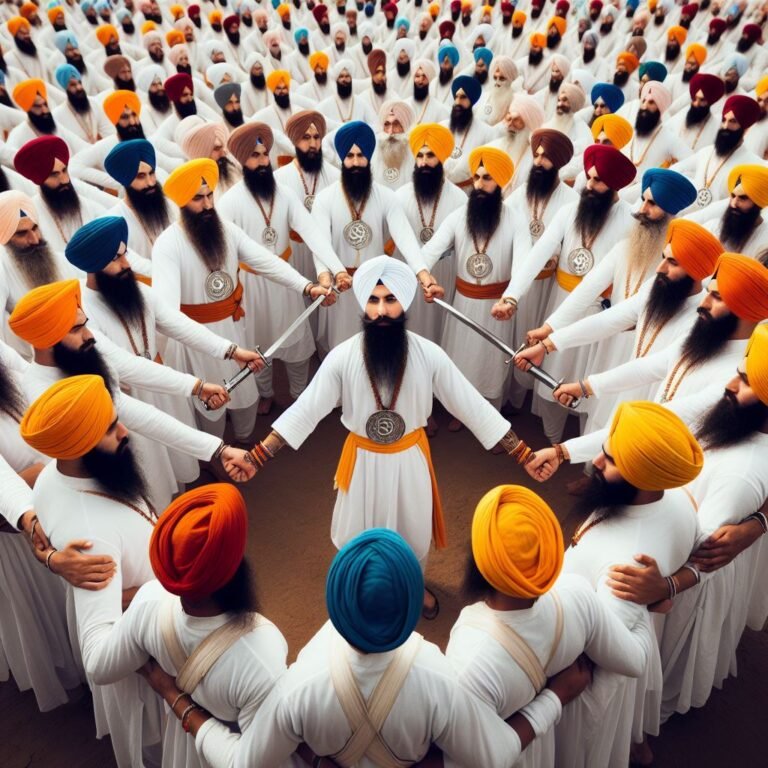Duties Of Khalsa

In one of his poems, Guru Gobind Singh Sahib defines the Khalsa :
“He who repeats night and day the name of Him,
Who has full love and confidence in God,
Who bestows not a thought on anv but one God,
Whose enduring light is inextinguishable,
Who puts no faith in fasting and worshipping cemeteries and monasteries,
Who only recognises the one God and makes no fetish, Of pilgrimages,
alms, charities and austerities:
He is recognised as a true member of the Khalsa,
In whose heart the light of the Perfect One shines.”
Guru Gobind Singh Sahib laid down the following duties for the Khalsa :
- The Khalsa is to worship one God and read Nitnem (Five Banis) and daily meditate on the Name.
- He is to keep the symbols (Panj Kakar) and to lead his life according to the Guru’s teaching. Gurmantra is Waheguru and the Basic creed is Mool-mantra.
- He has no caste after joining the brotherhood ; he has to repudiate non-Sikh rites and ceremonies, and follow only Sikh practices.
- He is not to commit ‘any of the four misdeeds (Kurahat) namely, the shaving or cutting of hair, eating Halal meat, adultery and the use of tobacco or any other intoxicant.
- He is not to commit any of the social offences (Tankhah), such as giving dowry, using liquors and intoxicants, raising monuments over graves and associating with apostates.
- He is to serve the sangat in all ways
- He must practice arms and be ready defend the weak.
The Khalsa was a saint-soldier wedded to the two-fold ideal of Bhagti and Shakti. He was to combine self-respect with humility.Guru Gobind Singh Sahib though a creator of the Khalsa regarded himself as their servent . He says, ” To serve them pleases me the most; no other service is so dear to my soul.” Like a loving father, he was prepared to forgive the sudden lapses of the Khalsa as in the case of the “Forty Immortals”, whom he claimed as his own in the nick of time. The Khalsa was given a position equal to that of the Guru. The Guru consists of two parts : the body and the Name. The Guru nominated the Khalsa, as his body and Guru Granth Sahib as the embodiment the Name. That is why we use the title of Guru-Khalsa. The Guru acknowledged his debt to the Khalsa in one of his verses.
“It is through them that I have gained experience ; with their help I have subdued my enemies. Through their favour, I am exalted, otherwise there are millions of ordinary humble men like me.”
Meaning of Symbols: Symbols or outward signs are a mode of discipline. A person who enters the Panth (Khalsa Community) will gladly embrace all its tenets and symbols. Symbols test the disciple’s firmness and strength of faith. They indicate the type of character the wearer should have. He must be proud of being a Sikh, even though it may cost him his life. Secondly this common appearance and uniform ensures easy recognition One can easily spot a Khalsa in a crowd. Each symbol has its own use and psychological significance.
The significance of Symbols-Panj Kakar- is given below :
- Underwear (Kachha) ensures agility and briskness. It is a mark of perpetual readiness. It also stands for chastity.
- Wrist-band (Kara) is a sign of restraint and bondage. It indicates that one is a devotee of the Guru. A look at the wrist-band will bring shame to a Sikh when he does any misdeed.
- Sword (Kirpan) is an emblem of power and courage. It is to be used primarily as an instrument of defence.
- Unshorn Hair (Kes) is an emblem of the saints and Rishis of the past.
- Comb (Kanga) is necessary to keep the hair clean and in shape. The hair make a Khalsa look exactly like Guru Gobind Singh Sahib and enable him to behave exactly like the Guru. Guru Gobind Singh Sahib says, “The Khalsa is my special form ;I live in the embodiment of the Khalsa. The Khalsa is a part and parcel of my body ; the Khalsa is my very soul.”
